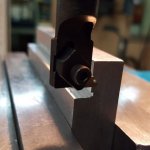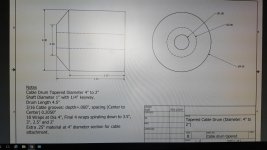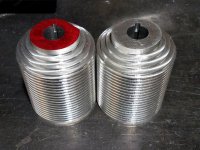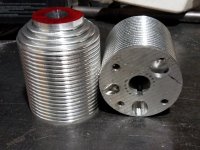I would like to machine a cable drum with grooves with my 3 axis bridgeport cnc mill. The cable drum needs to be 4.5" deep and 4" diameter. I plan to use a long 1" diameter endmill to clean all of the surfaces and then use a convex 3/32" radius milling cutter to cut the grooves. I don't see any problems in the machining until I get to the final milling where I have to cut the grooves. Being that the cable drum is 4.5" deep, I can't find a cutter that can reach the bottom without hitting the stock with tool holder. The only extension that I've been able to find is a 10" x 1" arbor shaft and then use a 3/32" milling cutter that fits a 1" arbor shaft. I haven't used any type of extension before so I am wondering if it would be safe to use an arbor in this situation. I am only trying to make a 0.060" depth cut in aluminum so it is very light machining, but I figured it would be safest to ask for opinions.
I have found accu hold end mill holder extensions, but the only 2 cutters I have found are 7/8" diameter at the cutter with 1/2" shank, or 2-1/4" cutter diameter around a 1" arbor. the 7/8" cutter shank is only 3" long so I would need an extension and the extensions are 3/4" or 1" diameter (would hit the workpiece).
NMTB 3 Milling Arbors 1" x 1" (LOC945) | Superior Machine & Tool
http://www.jtsmach.com/jtswebshop/Workholding/WH172.asp
3/16" x 2-1/4" x 1" Hole Convex Cutter | DrillsandCutters.com
Accu Hold End Mill Holder Extension Hi Precision 3/32 - 1 Inch Diameter 2.25 to 6.5 Long
I have only used erickson nmtb 30 tool holders in my mill and have a rough understand that I can use other nt/nst tool holders in my mill, but could need additional tools.
I know that I am pushing the limitations of my machine a bit and that a cnc lathe or 4 axis mill are more ideal for my project, but if my machine can do it, that would be by far the best option since we will most likely need to make several variations of the part.
Any serious help is appreciated.
I have found accu hold end mill holder extensions, but the only 2 cutters I have found are 7/8" diameter at the cutter with 1/2" shank, or 2-1/4" cutter diameter around a 1" arbor. the 7/8" cutter shank is only 3" long so I would need an extension and the extensions are 3/4" or 1" diameter (would hit the workpiece).
NMTB 3 Milling Arbors 1" x 1" (LOC945) | Superior Machine & Tool
http://www.jtsmach.com/jtswebshop/Workholding/WH172.asp
3/16" x 2-1/4" x 1" Hole Convex Cutter | DrillsandCutters.com
Accu Hold End Mill Holder Extension Hi Precision 3/32 - 1 Inch Diameter 2.25 to 6.5 Long
I have only used erickson nmtb 30 tool holders in my mill and have a rough understand that I can use other nt/nst tool holders in my mill, but could need additional tools.
I know that I am pushing the limitations of my machine a bit and that a cnc lathe or 4 axis mill are more ideal for my project, but if my machine can do it, that would be by far the best option since we will most likely need to make several variations of the part.
Any serious help is appreciated.
Last edited:




 )
)


